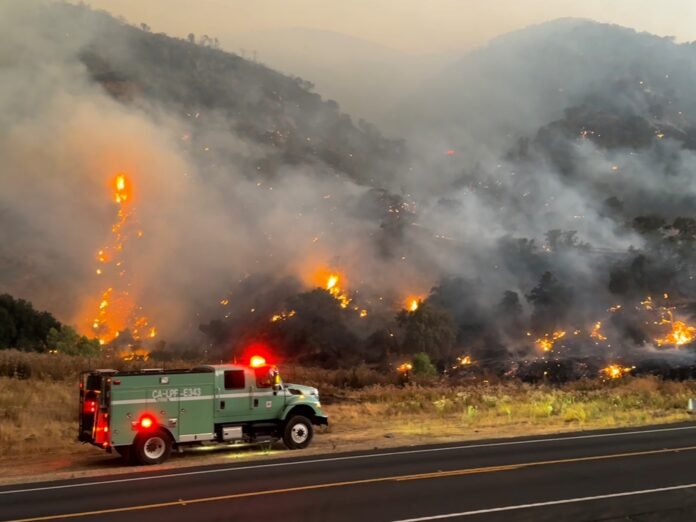By HawkFeed News | August 7, 2025
California isn’t new to wildfires. But this time, it’s different.
The Gifford Fire, raging across the sunbaked central stretches of Santa Barbara and San Luis Obispo counties, has grown into the largest wildfire California has witnessed in 2025, devouring nearly 84,000 acres of land as of early August 6.
And the fire is still hungry.
Despite the desperate resistance of nearly 1,900 firefighters, the blaze is only 9% contained, a statistic that tells more than just numbers—it whispers despair, screams exhaustion, and stands as a symbol of the climate crisis that’s no longer knocking at the door. It’s barged in.
A Fire Fueled by More Than Just Heat
The Gifford Fire didn’t just “start.” It erupted—intensified by bone-dry winds, record-high temperatures, and vegetation parched by years of erratic rainfall. Experts believe a possible lightning strike or human activity triggered the initial spark, though the official cause is still under investigation.
Within hours, that spark grew into a monster, turning blue skies into orange horror, swallowing oak groves, ranchlands, and rural homes in its wake.
And yet, if you scroll through national news cycles, you’ll find more talk of celebrity gossip than of evacuation alerts. Why? Who benefits from the silence?
Lives in Limbo
Over 700 structures are under threat, and thousands of residents have been forced to flee with whatever they could grab. Local schools have been shut down. Highway closures are wreaking havoc on transport. Wildlife is on the run, some never to return.
“There was fire in my backyard. My horses, my dogs, my kids—everything had to go in 10 minutes,” said Linda Garza, a ranch owner near Los Alamos. Her voice cracked, but not with weakness—with the sheer weight of watching a life get erased in real time.
For those with fire insurance, some sense of recovery may be possible. For others, especially undocumented workers and rural families with no safety nets—this is the kind of tragedy that becomes generational.
The Ecological Toll Nobody’s Counting
Lost in the numbers is something that doesn’t make headlines: biodiversity.
The Gifford Fire is torching critical habitats, including parts of the Los Padres National Forest, home to endangered species like the California condor and red-legged frog. Experts warn that some plant and animal life may be lost forever—collateral damage of a system that puts carbon profits over carbon balance.
And while helicopters drop retardants and brave crews dig containment lines, no policy-level urgency seems to match the scale of devastation. Why isn’t this being treated like a national emergency?
Whose Fire Is It, Anyway?
Here’s the uncomfortable truth: If this fire had broken out near Silicon Valley or Beverly Hills, we wouldn’t be talking about it like this. We’d have federal attention, donation drives, emergency declarations from the President, and trending hashtags.
Instead, the Gifford Fire burns in relative media obscurity—rural, working-class zones that power California’s agriculture but receive very little in return.
It’s a reminder that in America, even disasters are filtered through a lens of class, geography, and visibility.
A Future That’s Already Here
This isn’t just about fire. It’s about what happens when climate action is delayed, year after year, government after government.
California is experiencing longer fire seasons, drier winters, and hotter summers. The Gifford Fire isn’t an outlier—it’s a signal flare.
According to Cal Fire, wildfires in the state are expected to double in frequency and intensity over the next two decades. But here we are, watching the smoke rise while the climate debate still hinges on political convenience.
No Sirens, Just Silence
And so, the Gifford Fire keeps burning. The skies stay orange. The families stay scattered. The forests stay charred.
This isn’t just about California—it’s about a nation that’s grown too comfortable with crisis, too desensitized to sirens, and too distracted to notice when a fire stops being news and starts being the norm.
Will this be the fire that finally shifts something? Or will it simply be archived like the rest—another headline, another statistic, another forest gone?


